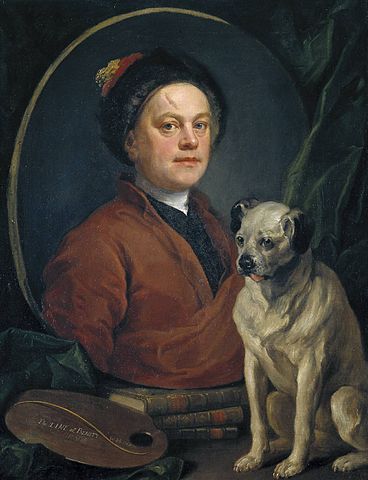
Born: 10 November 1697, London
Died: 26 October 1764 (aged 66)
Period: Baroque
The Life of William Hogarth
William Hogarth (1697–1764) was a British painter, printmaker, pictorial satirist, social critic, and editorial cartoonist, widely recognized as one of the most innovative artists of his time. Born in London to a lower-middle-class family, Hogarth rose to prominence through his keen observation of the complexities of human behavior and society, coupled with his distinctive and dynamic artistic style.
Early Life and Education Hogarth began his artistic career as an apprentice to a silver plate engraver, which laid the foundation for his exceptional skills in engraving. After completing his apprenticeship, he attended the St. Martin’s Lane Academy, where he studied painting. Eager to make a name for himself, Hogarth started as a freelance engraver, producing shop cards, book illustrations, and small portrait paintings.
Artistic Career Hogarth’s breakthrough came with the creation of “A Harlot’s Progress” (1732) and “A Rake’s Progress” (1735), a series of moral and satirical paintings that he engraved and sold as prints. These narrative series, depicting the rise and fall of individuals due to moral laxity, were highly successful and established Hogarth as a major figure in British art. He continued this success with subsequent series, including “Marriage A-la-Mode” (1743–1745).
Apart from his moral and satirical series, Hogarth also produced significant portraits, historical paintings, and religious works. His portrait of Captain Thomas Coram (1740) is among his most celebrated. He was also known for his theoretical work, “The Analysis of Beauty” (1753), in which he articulated his ideas about aesthetic beauty and the use of the serpentine line, or “line of beauty,” that influences visual arts.
Social Critic and Reformer Beyond his artistic achievements, Hogarth was deeply engaged with the social issues of his time. He was vocal about the rights of artists and was instrumental in the establishment of copyright laws to protect their work. His art often tackled subjects like poverty, prostitution, and the excesses of the upper classes, making him an important commentator on 18th-century society.
Legacy Hogarth died in London in 1764 and was buried at St. Nicholas Church, Chiswick. His legacy lies not only in his contribution to British art but also in his pioneering work in comic strip art and his influence on subsequent generations of artists and satirists. Hogarth’s ability to blend humor, satire, and moral commentary through his unique visual storytelling continues to be celebrated, making him a seminal figure in the history of art and social commentary.
William Hogarth’s Notable Works
William Hogarth, an 18th-century English artist known for his satirical works, made significant contributions to British art and social commentary through his paintings and engravings. Here are ten of Hogarth’s most famous works, showcasing his keen observation of society, penchant for satire, and moral commentary:
- “A Harlot’s Progress” (1732) – A series of six paintings (later made into engravings) depicting the tragic life and downfall of a young woman, Moll Hackabout, in London. This series brought Hogarth to the forefront of English art.
- “A Rake’s Progress” (1735) – Another series of eight paintings, telling the story of Tom Rakewell, a young man who squanders his fortune on luxurious living and vice, leading to his ultimate demise. The narrative arc mirrors that of “A Harlot’s Progress” and is equally critical of London society.
- “Marriage A-la-Mode” (1743-1745) – A series of six paintings satirizing arranged marriages among the aristocracy for monetary and social gain, highlighting the moral decay of the upper classes.
- “Beer Street and Gin Lane” (1751) – Two prints designed to be viewed together, contrasting the virtues of beer drinking with the vices associated with the consumption of gin, commenting on the gin crisis in London at the time.
- “The Four Stages of Cruelty” (1751) – A series of four engravings that depict the progression of cruelty, starting from the mistreatment of animals by a young boy, Tom Nero, leading to murder and his eventual execution. The series serves as a moral warning against cruelty and inhumanity.
- “The Analysis of Beauty” (1753) – A written work rather than a visual art piece, in which Hogarth outlines his theories on beauty, including the famous “Line of Beauty,” a serpentine curve that Hogarth believed embodied attractiveness and grace in art and nature.
- “The Election” series (c. 1754-1755) – A series of four paintings satirizing the corruption and chaotic proceedings of parliamentary elections in mid-18th-century Britain.
- “Industry and Idleness” (1747) – A series of twelve prints illustrating the lives of two apprentices, showcasing the rewards of hard work and the perils of laziness, aimed at a middle-class audience as a didactic work.
- “The March to Finchley” (1750) – A painting depicting British soldiers assembling on Tottenham Court Road on their way to guard against the Jacobite rebellion, showcasing Hogarth’s skill in capturing the complexity of contemporary life.
- “The Enraged Musician” (1741) – An engraving that humorously depicts a musician frustrated by the cacophony of sounds on a London street, critiquing the noise and chaos of urban life.
Hogarth’s work offers insightful commentary on the social, moral, and political issues of his time, making him one of the most important figures in the history of British art. His legacy endures through his influential approach to narrative in art and his pioneering role in the development of satirical visual commentary.